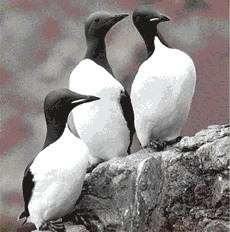Guillemot (Family: Alcidae, Genus: Uria) - Wiki Uria
From Wikipedia, the free encyclopedia
[Photo] Brunnich’s Guillemot, Uria lomvia and Common Murre from USGS. Caption: Common & Thick-billed Murres. Source; U.S. Geological Survey, Alaska Science Center - Biological Science Office, Seabird Tissue Archival and Monitoring Project. License: public domain
Uria is a genus of seabirds in the auk family. These are medium-sized guillemots with mainly brown or black plumage in the breeding season. They breed on the coasts of the northern Atlantic and Pacific Oceans
There are two species:
Common Guillemot or Common Murre, Uria aalge
Brunnich's Guillemot or Thick-billed Murre, Uria lomvia
Uria auks are relatives of the Razorbill, Little Auk and the extinct Great Auk and together make up the tribe Alcini. Despite the similar common names, they are not so closely related to the Cepphus guillemots which form the tribe Cepphini.
These birds breed in large colonies on coastal cliffs, their single egg being laid directly on a cliff ledge. They move south in winter to keep in ice-free waters.
They dive for food from the surface, swimming underwater. They mainly eat fish and crustaceans, also some molluscs, insects and plant material.
Adult birds are black or brown on the head, neck, back and wings with white underparts. The bill is long and pointed. They have a small rounded black tail. The lower face becomes white in winter.
The flight is strong and direct, and these species have fast wing beats due to the short wings.
Uria guillemots produces a variety of harsh cackling calls at the breeding colonies, but are silent at sea.
Some prehistoric Uria species are also known:
Uria bordkorbi (Monterey or Sisquoc Late Miocene of Lompoc, USA)
Uria affinis (Late Pleistocene of E USA) - possibly a subspecies of Uria lomvia
Uria paleohesperis
Uria brodkorbi is interesting insofar as it is the only known occurrence of the Alcini tribe in the temperate to subtropical Pacific, except for the very fringe of the range of U. aalge. It suggests that the Uria species, which are the sister taxon to all the other Alcini, and like them are usually believed to have evolved in the Atlantic, may have evolved in the Caribbean or possibly close to the Isthmus of Panama. The modern Pacific distribution would then be part of a later arctic expansion, whereas most other auk lineages form clades with a continuous range in the Pacific, from arctic to subtropical waters.
http://en.wikipedia.org/wiki/Uria
| The text in this page is based on the copyrighted Wikipedia article shown in above URL. It is used under the GNU Free Documentation License. You may redistribute it, verbatim or modified, providing that you comply with the terms of the GFDL. |
